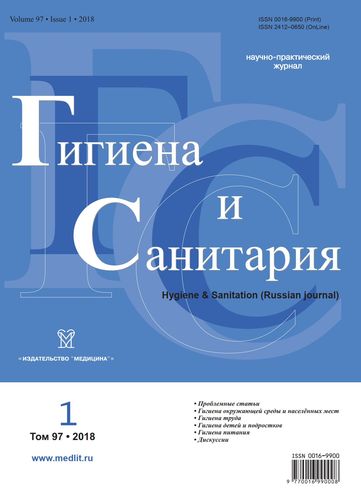Evaluation of health of the population living in the zone of the exposure to the plant on processing of ferrovanade alloys
- Authors: Maklakova O.A.1,2, Zaytseva N.V.1,2, Ustinova O.Y.1,2
-
Affiliations:
- Federal Scientific Center for Medical and Preventive Health Risk Management Technologies
- Perm State National Research University
- Issue: Vol 97, No 1 (2018)
- Pages: 21-24
- Section: ENVIRONMENTAL HYGIENE
- Published: 14.10.2020
- URL: https://rjsocmed.com/0016-9900/article/view/640301
- DOI: https://doi.org/10.47470/0016-9900-2018-97-1-21-24
- ID: 640301
Cite item
Full Text
Abstract
A total of 366 children aged from 4 to 10 years living in the territory with the presence of vanadium at atmospheric air at a level of up to 1.2 MPC average daily dose (MPC add) and manganese — up to 2.2 MPCadd were examined. In conditions of the chronic aerogenic exposure to vanadium and manganese, unacceptable levels of chronic non-carcinogenic risk to respiratory health (HI up to 72.3) and central nervous system (HI up to 41.3) are formed. The comparison group included 358 children of similar age who were not exposed to vanadium and manganese. In exposed children, the average content of vanadium and manganese in the blood appeared by 1.1–3.5 times higher than the reference levels and by 4.2 times than in the comparison group. During the clinical-functional and laboratory examination every second child with a high blood content of vanadium and manganese was established to show chronic respiratory diseases and pathology of the nervous system. It was noted that in the observation group chronic lymphoproliferative diseases of the nasopharynx are diagnosed by 2.3 times, chronic allergic rhinitis — by 8.5 times more frequently. Every third child of the observation group was revealed to have a restrictive disorder of breathing. The syndrome of autonomus dysfunction occurred in 12% of exposed children and manifested as sinus bradyarrhythmia or sinus tachycardia. Exposed children with a high blood content of vanadium and manganese develop oxidative stress (1.3 times increase in the content of lipid hydroperoxide, a 1.3-fold decrease in the level of total antioxidant status, superoxide dismutase in the blood serum), and a violation of the mechanisms of biological regulation at the molecular level (an increase in the level of nitric oxide, cyclic guanosine monophosphate, a decrease in the content of cyclic adenosine monophosphate).
About the authors
Olga A. Maklakova
Federal Scientific Center for Medical and Preventive Health Risk Management Technologies; Perm State National Research University
Author for correspondence.
Email: olga_mcl@fcrisk.ru
MD, PhD, head of the consultative out-patient department, Federal Scientific Center for Medical and Preventive Health Risk Management Technologies, Perm, 614015, Russian Federation; Perm State National Research University, Perm, 614990, Russian Federation.
e-mail: olga_mcl@fcrisk.ru
Russian FederationN. V. Zaytseva
Federal Scientific Center for Medical and Preventive Health Risk Management Technologies; Perm State National Research University
Email: noemail@neicon.ru
Russian Federation
O. Yu. Ustinova
Federal Scientific Center for Medical and Preventive Health Risk Management Technologies; Perm State National Research University
Email: noemail@neicon.ru
Russian Federation
References
- Bazdyrev E.D., Barbarash O.L. Ecology and cardiovascular diseases. Ekologiya cheloveka. 2014; (5): 53-8. (in Russian)
- Bilichenko T.N. Methodological aspects of the assessment of the influence of atmospheric air quality on the foaming of respiratory diseases in the population (Literature review). Pul’monologiya. 2006; (4): 94-103. (in Russian)
- Zaytseva N.V. Hygienic Aspects of Violation of Children’s Health under the Influence of Chemical Factors of the Environment [Gigienicheskie aspekty narusheniya zdorov’ya detey pri vozdeystvii khimicheskikh faktorov sredy obitaniya]. Perm’: Knizhnyy format; 2011. (in Russian)
- Zaytseva N.V., May I.V., Kleyn S.V. To the issue of establishing and proving harm to the health of the population in detecting unacceptable risk caused by environmental factors. Analiz riska zdorov’yu. 2013; (2): 14-26. (in Russian)
- Korochkina Yu.V., Perekusikhin M.V., Vasil’ev V.V., Panteleev G.V. Hygienic assessment of the environment and health of children in the city of Penza. Analiz riska zdorov’yu. 2015; (3): 33-9. (in Russian)
- Namazova-Baranova L.S., Kuchma V.R., Il’in A.G., Sukhareva L.M., Rapoport I.K. Incidence of children aged 5 to 15 years in the Russian Federation. Meditsinskiy sovet. 2014; (1): 6-10. (in Russian)
- The general morbidity of the Russian children’s population (0-14 years) in 2015: Statistical materials. Part VI. Moscow; 2016. (in Russian)
- State report «On the state of sanitary and epidemiological welfare of the population in the Russian Federation in 2015». Moscow; 2016. (in Russian)
- Gil’denskiol’d R.S., Novikov Yu.V., Khamidulin R.S., Aniskina R.I., Vinokur I.A. Heavy metals in the environment and their effect on the body (Review). Gigiena i sanitariya. 1992; 71(5-6): 6-9. (in Russian)
- Zemlyanova M.A., Tarantin A.V. Violations of the protein profile of a person under the influence of heavy metals. Ekologiya cheloveka. 2012; (7): 7-14. (in Russian)
- Soodaeva S.K. Free radical mechanisms of damage in diseases of the respiratory system. Pul’monologiya. 2012; (1): 5-10. (in Russian)
- Draft Toxicological Profile for Vanadium: U.S. Department of Health and Human Services. Agency for Toxic Substances and Disease Registry. Atlanta; 2009.
- Draft Toxicological Profile for Marganese: U.S. Department of Health and Human Services. Agency for Toxic Substances and Disease Registry. Atlanta; 2008.
- Glantz S.A. Primer of Biostatistics. New-York: McGraw-Hill; 1994.
Supplementary files









